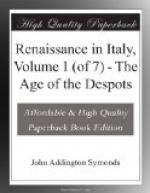and the bottega, or place of business.
What follows is principally concerned with the details
of economy. Expenses are of two sorts: necessary,
for the repair of the house, the maintenance of the
farm, the stocking of the shop; and unnecessary, for
plate, house decoration, horses, grand clothes, entertainments.
On this topic Agnolo inveighs with severity against
household parasites, bravi, and dissolute dependents.[5]
A little further on he indulges in another diatribe
against great nobles, i signori, from whom he
would have his sons keep clear at any cost.[6] It
is the animosity of the industrious burgher for the
haughty, pleasure-loving, idle, careless man of blood
and high estate. In the bourgeois household described
by Pandolfini no one can be indolent. The men
have to work outside and collect wealth, the women
to stay at home and preserve it. The character
of a good housewife is sketched very minutely.
Pandolfini describes how, when he was first married,
he took his wife over the house, and gave up to her
care all its contents. Then he went into their
bedroom, and made her kneel with him before Madonna,
and prayed God to give them wealth, friends, and male
children. After that he told her that honesty
would be her great charm in his eyes, as well as her
chief virtue, and advised her to forego the use of
paints and cosmetics. Much sound advice follows
as to the respective positions of the master and the
mistress in the household, the superintendence of
domestics, and the right ordering of the most insignificant
matters. The quality of the dress which will
beseem the children of an honored citizen on various
occasions, the pocket money of the boys, the food
of the common table, are all discussed with some minuteness:
and the wife is made to feel that she must learn to
be neither jealous nor curious about concerns which
her husband finds it expedient to keep private.
[1] I ought to state that Pandolfini is at least a century earlier in date than Casliglione, and that he represents a more primitive condition of society. The facts I have mentioned about his life are given on the authority of Vespasiano da Bisticci. The references are made to the Milanese edition of 1802. It must also be added that there are strong reasons for assigning the treatise in question to Leo Battista Alberti. As it professes, however, to give a picture of Pandolfini’s family, I have adhered to the old title. But the whole question of the authorship of the Famiglia will be fully discussed in the last section of my book, which deals with Italian literature. Personally. I accept the theory of Alberti’s authorship.
[2] A beautiful description of the religious temper, p. 74.
[3] What Pandolfini says about
the beauty of the body is worthy of a
Greek: what he says about
exercise might have been written by an
Englishman, p. 77.
[4] Pp. 82-89 are very important
as showing how low the art of
politics had sunk in Italy.




